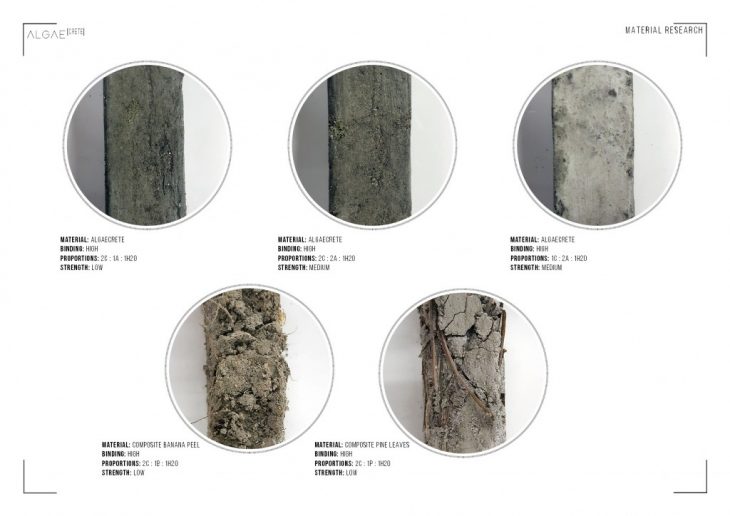ALGAE[CRETE] Structural Performance Tests
Biology Workshop
This research proposes the use of biomass from filamentous algae (Spirogyra sp.) as a lightweight reinforcement for cementitious composites to derive materially efficient fibrous constructs. The aim of this test is to prove if the use of algae fibers are capable of improving the structural performance of a cementitious composite (Algaecrete).
MATERIALS
The algae fibers (Spirogyra sp.) were sourced from the irrigation canal Rec Comtal in Barcelona, Spain. The source algae were washed thoroughly with tap water to remove the additional organic material attached to the fibers, and later on disinfected in a 5% solution of Hydrogen Peroxide and Alcohol for 90 s. The fibers were washed again with tap water and kept soaked for the concrete mixture. Additionally, Banana peal fibers and Pine leaves biomass were also used to compare the applicability of waste biomass in cementitious composites and their behavior as possible aggregates. The pine leaves were sourced from Pine Trees in Valldaura, outside Barcelona, they were washed with tap water and kept soaked. The banana peals were sourced from a local market, they were dried at 100 degrees for 1200 s. The used concrete is a fast-curing premix from the brand Geolite Kerakoll. All the samples were used after a day of being casted in 25x25x100 mm wooden molds and uncasted after a day.
The samples were placed under a Flexural strength testing machine. The variables in the trial test included the type of fibers, the volumetric ratio of the added fibers and the reduction in the amount of concrete.
OBSERVATIONS
- The composites of Banana peal and Pine leaves were not suitable for the test. Further research is recommended in order to determine the reasons for the incomplete binding with the concrete. Such samples were highly fragile and brittle.
- All the samples with different variations of algae fibers had a optimal binding with the concrete particles.
- The samples Given in Fig. 1 (From left to right) are 1, 2 and 3. The sample No. 1 failed the test at 0.7 Bar, while the samples 2 and 3 failed at 1 Bar.
- The more algae fibers used, the more lightweight the composite is.
- The more algae fibers used, the more porosity the composite has ergo there is a potential for bio-receptivity.
- Further research needs to be conducted with different sizes of the algae fibers, processed fibers (chemical treatments) and curing time.
